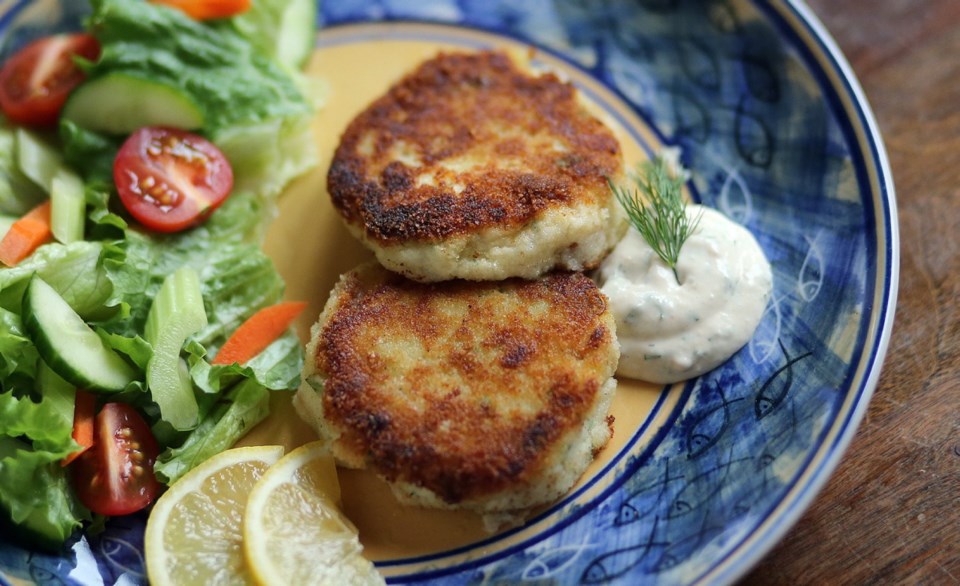 Dear Eric: I was in Country Grocer (supermarket) and spied some mackerel. It reminded me from years ago that that fish was used to make finnen and hattie (spelling?).
Dear Eric: I was in Country Grocer (supermarket) and spied some mackerel. It reminded me from years ago that that fish was used to make finnen and hattie (spelling?).
I asked the butcher, but he had never heard of it and I couldn’t find it in any cookbooks that I have.
I remember that it was very tasty and not a complicated recipe.
Helen Alexander
Dear Helen: I’m assuming the butcher you spoke with was also in charge of the seafood area, as you were asking him about a fish product. He or she probably had not heard of finnen and hattie, not because you named it slightly incorrectly; it’s actually spelled “Finnan haddie.” And not because they got confused when you gave them the wrong name of the fish species it’s made from.
Finnan haddie is not made from mackerel; cold-smoking haddock is how it’s made. Cold smoking, as its name suggests, means the lightly salted or brined fish is smoked at cool temperatures, giving the fish a delicately smoky taste and a slightly firm, almost silky and appealing texture.
If you’ve not had Finnan haddie for a while, I can understand how you could make that mistake because mackerel is also smoked. But mackerel is a denser, stronger-tasting, oily fish, while haddock is mild-tasting fish that’s related to cod and is harvested from the North Atlantic.
Finnan haddie originates from Scotland. Several sources say the first part of its name comes from the place haddock was first smoked this way. That is the Aberdeen fishing village of Findon, which is locally pronounced as “Finnan.” Haddie is Scottish for haddock.
Put the two together and you get Finnan haddie, but these days the name is also used in other places where smoked haddock is produced, such as Nova Scotia and Maine.
Helen, it’s unlikely you would find a recipe for smoking and making your own Finnan haddie in one of your cookbooks. But what you might find are ways to use that smoked fish in a recipe or simple ways to prepare it, the latter of which is what I think you are remembering.
According to the New Food Lover’s Companion, Finnan haddie poached in milk has long been a favourite breakfast dish in the British Isles. You can also prepare it that way for dinner by adding onions and other flavourings to the milk, which you can thicken with butter and flour, creating a fish stew.
Finnan haddie can also be simply grilled with butter and served as is, or topped with cream sauce. It can also be cubed and added to any dish where a smoked fish flavour would be welcome, such as a fish pie, egg dish or soup, such as chowder or the interestingly named Cullen skink, a traditional Scottish fish soup.
I’ve also seen Finnan haddie added to fish cakes, and that is what I had planned to do in today’s recipe. However, when I went to my local supermarket, they didn’t have it, and when they checked with Victoria’s major seafood wholesalers, they were unable to secure any and were not sure when they would be able to get it.
So, as a substitute, I used B.C. cold-smoked sablefish, which is often called smoked black cod. It has a similar delicate smoky taste and beautiful texture and can be prepared in similar ways to Finnan haddie, and it worked well in my fish cakes. You have the option to use Finnan haddie when it is available locally.
Smoked Fish and Potato Cakes with Dill Horseradish Sauce
Moist, rich and smoky-tasting fish cakes you could serve with a side salad.
Preparation time: 30 minutes
Cooking time: 25 minutes
Makes: four servings
For the sauce
1/2 cup mayonnaise
2 tsp chopped fresh dill
2 tsp horseradish
1 tsp Dijon mustard
• salt and white pepper to taste
Combine all the ingredients in a small bowl. Cover and refrigerate until the cakes are cooked.
For the fish cakes
1 1/4 lb. baking potatoes (about 2 medium), peeled and quartered
250 grams cold-smoked sablefish (also called smoked black cod) or Finnan haddie (smoked haddock), skin removed and patted dry
2 tsp chopped fresh dill
2 green onions, thinly sliced
1 large egg
2 Tbsp all-purpose flour
• salt and white pepper to taste
1/2 cup dried breadcrumbs
3 Tbsp vegetable oil
• lemon slices and dill sprigs for garnish
Place the potatoes in a medium pot, cover with two inches of cold water and bring to a simmer. Simmer the potatoes until tender. Drain the potatoes very well, and then thoroughly mash. Spoon into a medium bowl and cool to room temperature.
Cut the fish into thin strips and remove any bones that you find. Cut each strip into tiny cubes and set in the bowl with the potatoes. Add the dill, green onion, egg, flour, salt and pepper, and mix to combine.
Line a baking sheet with parchment paper. With lightly cold-water-dampened hands, form fish mixture into eight cakes, each about three inches wide, and set them on the baking sheet.
Spread the breadcrumbs on a wide plate. Coat each cake in breadcrumbs, gently pressing them on to help them adhere, and then set back on the baking sheet. (Cakes can be made a few hours in advance then covered and refrigerated until ready to cook.)
To cook cakes, pour the oil into a large skillet or electric griddle set to medium or medium-high heat. When the oil is hot, fry the fish cakes until golden brown and piping hot throughout, about four minutes per side.
Set two cakes on each serving plate with a dollop of the sauce. Garnish with lemon slices and dill sprigs and serve.
Eric Akis is the author of the hardcover book Everyone Can Cook Everything. His columns appear in the Life section Wednesday and Sunday.



